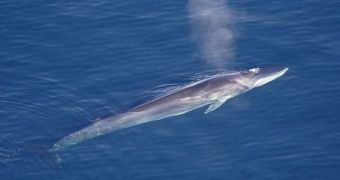As the Arctic is heating up, more and more whales and ships are making their way through the Bering Strait every year, researchers at the University of Washington have determined in a new study. The number of whales moving through this passage was quantified using underwater listening devices.
According to the investigation, sub-Arctic whales have the most to gain from retreating annual sea ice extents, since they can extend their old ranges the most. As the Bering Strait remains free for longer than ever before, the marine animals have access to larger habitats for longer periods of time.
In order to arrive at these conclusions, UW scientists collected underwater microphone recordings spanning a total of three years and tracked several whale species by the signature sounds they were releasing. This enabled them to figure out which species took advantage of the open gate to ice-free waters.
Both Arctic and sub-Arctic whales were found to be heading towards the Arctic Ocean in greater numbers than before. Details of the investigation were presented at the Ocean Sciences meeting in Honolulu, on February 26. The presentation was held by oceanographer Kate Stafford, from the UW Applied Physics Laboratory.
Arctic whales found to be traveling through the passage included beluga and bowhead, whereas sub-Arctic whales included fin, humpback, and killer. The latter were primarily traveling through the Bering Strait to reach the rich feeding grounds of the Chukchi Sea.
The research was part of a US-Russian scientific collaboration and lasted from 2009 to 2012. Numerous microphones were placed just under the surface of the water and were used to listen for the typical calls of several whale species. These sound signatures were known from previous studies.
“It's not particularly surprising to those of us who work up in the Arctic. The Arctic seas are changing. We are seeing and hearing more species, farther north, more often. And that's a trend that is going to continue,” Stafford said yesterday.
“These animals are expanding their range,” Stafford added. “They're taking advantage of regions in seasons that they may not have previously,” the investigator continued, quoted by e! Science News.
Another significant finding was that the number of ships passing through this corridor – which contains two major shipping lanes – increased considerably over the three-year period. This poses a series of hazards to the whales, including collisions and the all-feared noise pollution.
“Marine mammals rely primarily on sound to navigate, to find food and to find mates. Sound is their modality. If we increase the ambient sound level, it has the potential to reduce the communication range of cetaceans and all marine mammals,” Stafford concluded.

 14 DAY TRIAL //
14 DAY TRIAL //